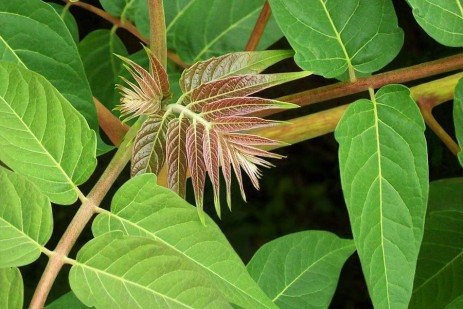Posted: July 12, 2019
Ailanthus altissima, commonly referred to as tree-of-heaven, is a rapidly growing deciduous tree native to northeast and central China, as well as Taiwan. It was first introduced into the United States in the late 1700s. Initially, it was valued as an urban street tree and was widely planted in the mid-Atlantic region. From there, tree-of-heaven has spread across the nation and become a common invasive weed in urban, agricultural, and forested areas.

Tree-of-heaven is an invasive plant and preferred host for the spotted lanternfly. (Photo by Biogstock.)
Tree-of-heaven can quickly overwhelm roadsides, fields, and natural areas, crowding out native plant communities, leading to a decline in native plant species diversity, slowing or halting natural succession, and degrading wildlife habitats.
Tree-of-heaven is also a preferred host for the newly discovered spotted lanternfly (SLF), an invasive planthopper native to Asia. SLF also feeds voraciously on many plants, including economically important crops like fruit trees, grapevines, hops, hardwoods, and ornamentals. Current SLF management efforts are focused on controlling this tree.
Due to its size and extensive spreading root system, tree-of-heaven control is challenging. Simply cutting the tree down causes it to send up vigorous stump and root sprouts. To control the tree, you must control the roots. The most effective way to do this is by applying systemic herbicides at the optimum time of year, when the tree is moving sugars, produced through photosynthesis, down to its roots. This is best accomplished in mid- to late summer, July through September.
There are three herbicide application methods effective at controlling tree-of-heaven: foliar sprays, basal bark, and hack-and-squirt. Stump treatments of tree-of-heaven are largely ineffective; they keep the stump from re-sprouting but are not likely to prevent root suckering. For most treatments, herbicides containing the active ingredients glyphosate or triclopyr are effective. If a tree has to be removed, wait 30 days for the herbicide to take effect, and then cut the tree.
Following initial treatments, monitor the site for signs of regrowth and re-treat as necessary. Initial treatments often only reduce the root system, making follow-up measures essential. This is critical to prevent re-infestation. Well-established tree-of-heaven stands are only eliminated through repeated efforts.
For more information on tree-of heaven control strategies visit the Penn State Extension website. Two recently produced short videos are now available which thoroughly cover the methodology. The videos are entitled Controlling Tree-of-Heaven: Why it Matters and Tree-of-Heaven: Control Strategies.
Additional Resources:
Video: Tree-of-Heaven: Accurate Identification
Video and article: Identifying Tree-of-Heaven and Some Native Look-a-Likes
Forest Leaves, Autumn 2018 Issue, page 2
Fact Sheet: Tree-of-Heaven
James C. Finley Center for Private Forests
Address
416 Forest Resources BuildingUniversity Park, PA 16802
- Email PrivateForests@psu.edu
- Office 814-863-0401
- Fax 814-865-6275
James C. Finley Center for Private Forests
Address
416 Forest Resources BuildingUniversity Park, PA 16802
- Email PrivateForests@psu.edu
- Office 814-863-0401
- Fax 814-865-6275

